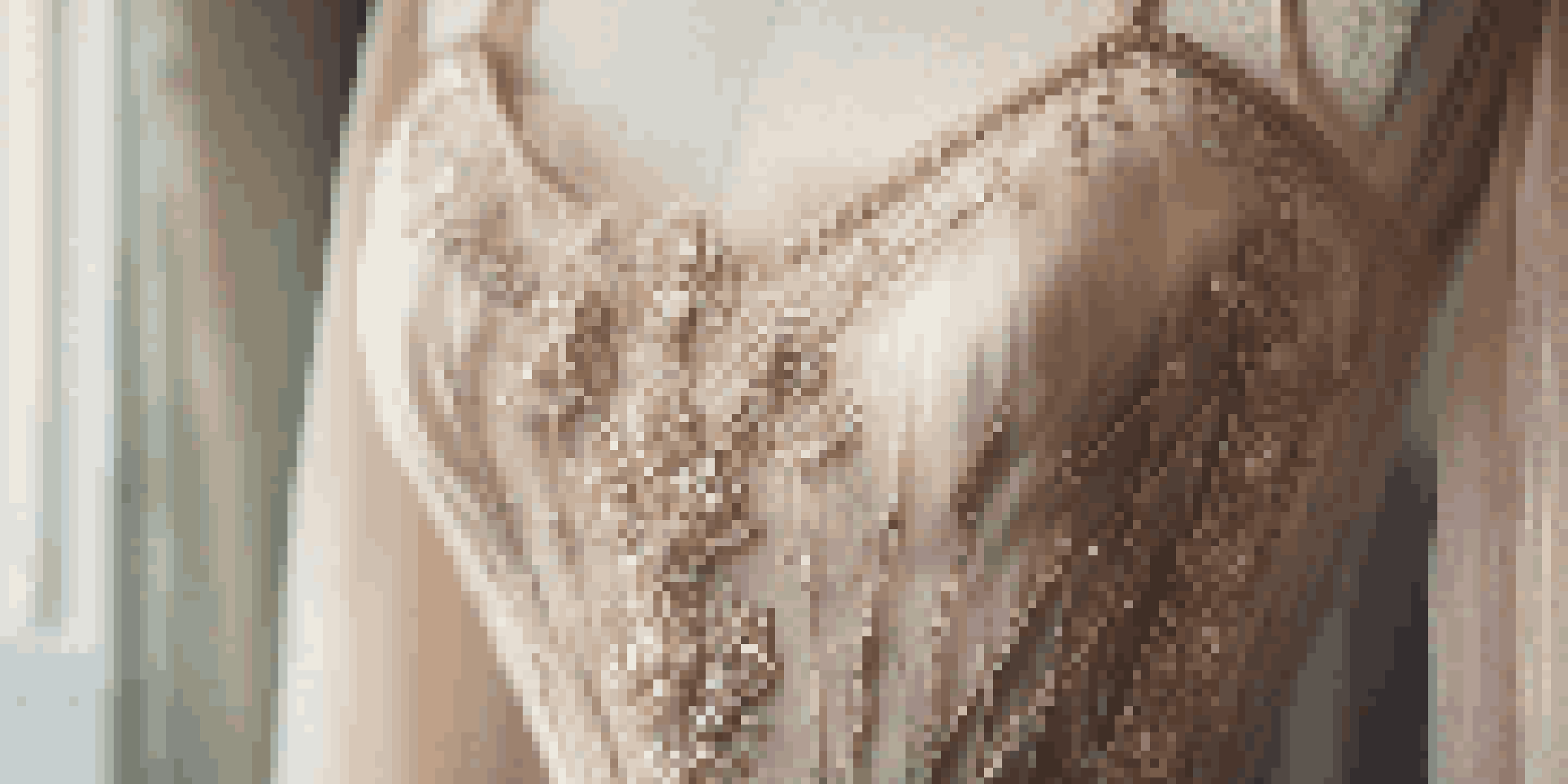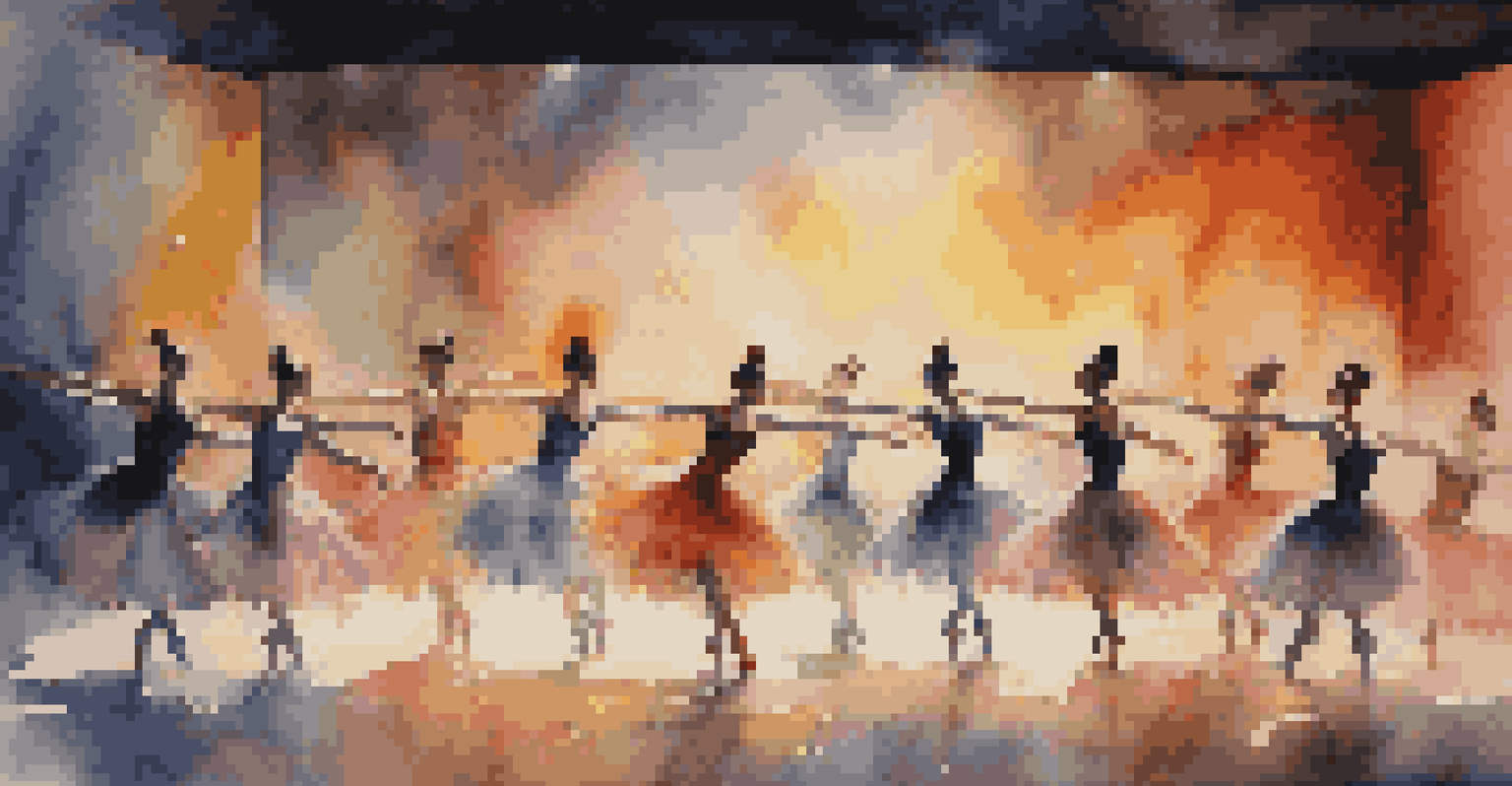Costume Design for Ballet: A Study of Classical Techniques

The Importance of Costume in Ballet Performance
Costume design plays a vital role in ballet, as it not only enhances the visual appeal but also supports the narrative. Think of the costume as a character in itself, helping to communicate emotions and themes without uttering a single word. For instance, the delicate fabrics and flowing silhouettes of a swan costume can evoke grace and beauty, complementing the dancer's movements.
Costumes are the silent narrators of a ballet, conveying emotions and stories without a word being spoken.
Beyond aesthetics, costumes can also influence how a dancer performs. The weight, fit, and structure of a costume can enhance or hinder a dancer's ability to execute specific movements. For example, a tutu allows for greater freedom of movement, while a long gown might restrict leg extension, affecting performance dynamics.
Ultimately, the right costume can elevate a performance, creating a mesmerizing experience for the audience. When designed thoughtfully, costumes work in harmony with choreography and music, weaving together the elements of storytelling that make ballet so enchanting.
Historical Influences on Ballet Costume Design
Ballet costume design has evolved significantly over the centuries, influenced by various historical periods and cultural shifts. In the early days of ballet, costumes were often heavy and ornate, reflecting the extravagance of royal courts. For example, the elaborate dresses worn during the Baroque period emphasized grandeur, while the Romantic era introduced lighter fabrics that allowed for more fluid movement.

As ballet transitioned into the 20th century, costume design began to embrace modernity and functionality. Designers like Coco Chanel and Christian Dior brought innovative ideas to the ballet stage, merging high fashion with practical performance wear. This shift allowed for costumes that not only looked stunning but also supported the dancer's physicality.
Costumes Enhance Ballet Narratives
Costume design is crucial in ballet, as it not only beautifies the performance but also communicates emotions and themes without words.
Today, costume designers draw inspiration from both historical and contemporary sources, creating a rich tapestry of styles. This blend of old and new not only pays homage to ballet's roots but also pushes the boundaries of what ballet costumes can achieve.
Materials Used in Ballet Costume Design
Selecting the right materials is crucial in ballet costume design, as the fabric can greatly affect the overall look and feel of the performance. Common materials include silk, tulle, and lycra, each chosen for their unique properties. Silk offers a luxurious sheen, while tulle adds volume and a dreamy quality, perfect for tutus.
Fashion is not something that exists in dresses only. Fashion is in the sky, in the street, fashion has to do with ideas, the way we live, what is happening.
Moreover, durability is a key factor in material selection. Ballet costumes undergo rigorous movement and must withstand wear and tear during performances. Designers often blend materials to create costumes that are both visually appealing and practical, ensuring they can endure the demands of rigorous rehearsals and shows.
The choice of materials also extends to the color and texture, allowing designers to convey specific themes or emotions. For instance, a dark, textured fabric might evoke a sense of mystery, while bright colors can suggest joy and energy, enhancing the storytelling aspect of the performance.
Techniques in Creating Ballet Costumes
Creating a ballet costume involves a myriad of techniques, each contributing to the final product. Initially, designers sketch their ideas, considering the character, narrative, and movement. These sketches serve as a blueprint, guiding the selection of fabrics, colors, and construction methods.
Once the design is finalized, the next step is pattern making, where templates for each costume piece are created. This is a meticulous process that requires precision, as the fit is paramount in ensuring the dancer can perform without restriction. For instance, a well-fitted bodice allows for both support and freedom of movement.
Historical Evolution of Costumes
Ballet costumes have evolved significantly over time, transitioning from ornate designs in royal courts to modern, functional styles that support performers.
Finally, sewing and embellishment bring the costume to life. This stage often involves intricate detailing, such as embroidery or the addition of accessories, which can enhance the visual impact on stage. The culmination of these techniques results in a costume that is not just clothing but an integral part of the ballet experience.
Color Theory in Ballet Costume Design
Color theory plays a pivotal role in ballet costume design, influencing both the emotional response of the audience and the overall aesthetic of the performance. Each color carries its own symbolism; for example, red can evoke passion, while blue might suggest calmness. Designers carefully choose colors to align with the narrative and character traits.
Moreover, the combination of colors can create dynamic visual impacts. Designers often use contrasting colors to highlight specific movements or themes, drawing the audience's eye to the dancers. For instance, a bright costume against a dark backdrop can create a striking visual that emphasizes the dancer's grace.
Understanding how colors interact under stage lighting is also essential. The way colors appear on stage can differ significantly from their appearance in natural light, so designers must consider how lighting will affect the overall look. This attention to detail ensures that the costumes resonate with the audience in the intended way.
The Role of Technology in Costume Design
In recent years, technology has revolutionized the way costume designers create and conceptualize their work. Advanced software allows designers to create digital sketches and prototypes, streamlining the design process and enabling more efficient collaboration with choreographers and directors. This technology opens up new possibilities, allowing for more intricate designs and creative experimentation.
3D printing has also made waves in costume design, enabling the creation of complex structures that would be challenging to achieve with traditional methods. For instance, intricate masks or accessories can be produced with precision, adding a unique flair to the overall costume without compromising on performance functionality.
Technology Transforms Costume Design
Advancements in technology, such as digital design and 3D printing, are revolutionizing ballet costume creation, allowing for intricate and functional designs.
Furthermore, technology extends to the materials used in costume design. Innovations in fabric technology have led to the development of lightweight, breathable materials that offer greater comfort and flexibility. This evolution not only enhances the dancer's performance but also enriches the visual storytelling of the ballet.
Future Trends in Ballet Costume Design
As ballet continues to evolve, so too does the realm of costume design, reflecting broader trends in art, culture, and technology. Sustainability is becoming a significant focus, with designers exploring eco-friendly materials and practices. This shift not only addresses environmental concerns but also resonates with audiences increasingly aware of sustainability issues.
Additionally, there is a growing trend towards inclusivity and diversity in ballet costume design. Designers are rethinking traditional silhouettes and color palettes to represent a wider range of cultures and identities. This inclusivity enriches the storytelling aspect of ballet, allowing for a more relatable and expansive narrative.

As we look to the future, it’s clear that ballet costume design will continue to innovate, pushing the boundaries of creativity while honoring the art form's rich history. With each new production, designers will undoubtedly seek to inspire and enchant audiences, ensuring that the art of ballet remains vibrant and relevant.